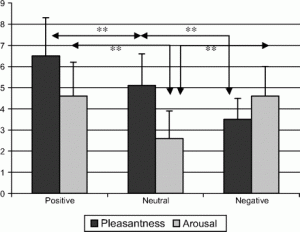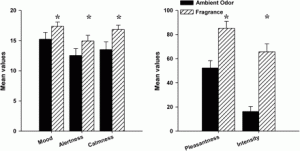Welcome back! I have some sad news for you, dear reader, this is going to be my final blog post on emotion and the senses (cue tears). My past entries were on senses in general, vision, and hearing. This week will be on a sense that seems to be perfect for the season: smell.

Holiday smells can bring back waves of emotions!
The holiday season is full of smells that can activate our emotions: the warm hug of gingerbread, crisp energy of pine tree, and the comfort of a crackling fireplace. Sound familiar? Advertisers prey upon these smell and emotion links because we can all understand them. This post will look at how smell and emotion influence each other as well as how those with improperly functioning smell have their emotions impacted.
Smell can influence our interpretation of our emotions. Weber and Heuberger (2008) exposed participants to smells or had them in a control condition. The experimental group smelled different plants and then rated their mood, calmness, and alertness on a scale and the pleasantness of smell. Participants smelling the plants rated themselves as higher in mood, alertness, and calmness compared to a control group. This was also seen in a follow-up experiment that minimized visual stimuli to isolate the effect to smell. Artificial smells did not show the same results. This implies that smells, when natural, can improve overall emotional functioning. Perhaps this comes from biological link to finding pleasant smells in nature when we were a more hunter-gatherer based society. Pleasant smells may indicate food or nourishment which calms us and puts us in a better mood. Artificial smells do not activate these same links. While this study utilized pleasant odors, more than just the pleasantness of odors can also impact our emotional processing.

One of the smells Delplanque et al. (2008) used was skunk odor. Participants did not rate it as very pleasant!
Delplanque et al. (2008) exposed participants to a variety of “complex” odors (such as cake, buttered popcorn, skunk, and leather). Participants rated these upon pleasantness and familiarity. Familiar odors were found to be rated as more pleasant only if the odor is a traditionally “good” smelling odor. This was not true for bad
smelling odors. However, the researchers also said that familiarity was not very high for bad odors. This makes sense. Think about a perfume that someone close to you wears. It is something that is familiar and has perhaps had more of a chance to be tied to positive experiences. This is less likely for unpleasant smells because we may have only experienced them a few times and only in bad situations. The same study was repeated but skin conductance was added as an additional measure. The more familiar and pleasant (the earlier relationship remained the same) odors were, the less skin conductance was seen. This shows that our bodies are in an overall calmer state with positive and familiar smells. They do not instill a state of fear or nervousness. Which is good, because who wants to start sweating the moment they smell cookies baking? Not me! What about the other end of the relationship? Our emotional state can also influence our sense of smell.

Males and females both rated odor pleasantness differently depending on the type of picture they saw (Pollatos et al., 2007)
Pollatos et al. (2007) looked at the impact of emotion on smell. Participants viewed emotional and neutral pictures. Participants then had to smell three odors and identify which one was different. They also rated the pleasantness and strength of the odor. They found that specifically males had better olfactory perception after viewing unpleasant pictures. After viewing pleasant pictures, both sexes rated the smells as more intense. This means that there is some influence of emotional state on our smell perception. When participants are happy, it is possible that they increased breathing and thus overall intake of smell. When participants were unhappy and had better perception, this may tie to a more biological stat. Examples are a fear of negative smells and a need to identify toxins. We have seen how smell and emotion interact, but what about those with improperly functioning olfactory systems?
Having an olfactory order – a dysosmia –impacts one’s emotions. A review by Soudry et al. (2011) outlines the effects. Our olfactory system and our emotional system interact with similar parts of the brain including the amygdala, OFC, and the ACC. This results in relationships between emotional functioning and dysosmias. There are not many studies currently, but a few have shown a positive correlation between dysosmia and major depressive disorder. Others show a correlation between schizophrenia and dysosmia. It is also seen that being able to smell is needed to properly evaluate environments as positive or negative. All of these links are likely due to the overlap in brain areas. This highlights the importance of functioning smell and functioning emotions.
Even if we may not realize it, smell is very important for our emotions. Smells allow us to feel more happy, calm, or alert. They also can remind us of familiar (and perhaps then emotional moments). On the other hand, our emotional state can affect our smell perception. Those without properly functioning olfactory systems may also show non-functioning emotions by displaying different mood disorders such as depression or schizophrenia. Our nose is more important than just telling us that someone is baking cookies in the next room. No, it can also help us realize how to feel about those cookies. Unfortunately, I have no cookies to give you, but I hope thinking of the smell makes you happy enough.
References
[Candle Image] Retrieved December 6, 2014, from: http://www.goodhousekeeping.com/holidays/gift-ideas/housewarming-gifts/perfect-christmas-collection-gift
[Skunk Image] Retrieved December 6, 2014, from: http://animals.nationalgeographic.com/animals/mammals/skunk/
Delplanque, S., Grandjean, D., Chrea, C., Aymard, L., Cayeux, I., Le Calve, B., … & Sander, D. (2008). Emotional processing of odors: evidence for a nonlinear relation between pleasantness and familiarity evaluations. Chemical Senses, 33(5), 469-479.
Pollatos, O., Kopietz, R., Linn, J., Albrecht, J., Sakar, V., Anzinger, A., … & Wiesmann, M. (2007). Emotional stimulation alters olfactory sensitivity and odor judgment. Chemical senses, 32(6), 583-589.
Soudry, Y., Lemogne, C., Malinvaud, D., Consoli, S. M., & Bonfils, P. (2011). Olfactory system and emotion: common substrates. European annals of otorhinolaryngology, head and neck diseases, 128(1), 18-23.
Weber, S. T., & Heuberger, E. (2008). The impact of natural odors on affective states in humans. Chemical senses, 33(5), 441-447.

